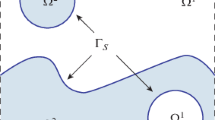Abstract
A numerical method that can treat a contact discontinuity as a sharp discontinuity is proposed by introducing a density function. The surface of the density function representing the discontinuity can be described with alomost one grid on an Eulerian formulation throughout the calculation even if the surface distortion is large. The algorithm is based on the CIP (cubic-interpolated propagation) method combined with variable transformation. Smearings of the discontinuity are overcome without using any special treatment to the surface. Dependent variables on both sides of the surface are computed in a normal procedure. The present scheme is applied both to a compressible flow and quasi-incompressible flow accompanying shock discontinuities. The result exhibits advantages of this method in robustness and efficiency.
Similar content being viewed by others
References
Daly BJ (1969) A technique for including surface tension effects in hydrodynamic calculations. J Comput Phys 4:97
Harlow FH, Amsden AA (1968) Numerical calculation of almost incompressible flow. J Comput Phys 3:80
Hirt CW, Nichols BD (1981) Volume of fluid (VOF) method for the dynamics of free boundary. J Comput Phys 39:201
Nichols BD, Hirt CW (1971) Improved free surface boundary conditions for numerical incompressible-flow calculations. J Comput Phys 8:434
Unverdi SO, Tryggvason G (1992) A front-tracking method for viscous, incompressible, multi-fluid flows. J Comput Phys 100:25
Wang PY, Yabe T, Aoki T (1993) A general hyperbolic solver — the CIP method applied to curvilinear coordinate. J Phys Soc Japan 62:1865
Yabe T, Ishikawa T, Wang PY, Aoki T, Kadota Y, Ikeda F (1991) A universal solver for hyperbolic equations by cubic-polynomial interpolation II. Two- and three-dimensional solvers. Comput Phys Comm 66:233
Yabe T, Wang PY (1991) Unified numerical procedure for compressible and incompressible fluid. J Phys Soc Japan 60:2105
Yabe T, Mochizuki T, Hara H (1992) Multi-dimensional hydrodynamic simulation of laser-induced evaporation dynamics. In: Matsunawa A, Katayama S (eds) Proc of laser advanced materials processing (LAMP) '92, Nagaoka, Japan, June, 1992. pp 387–392
Yabe T, Xiao F (1993) Description of complex and sharp interface during shock wave interaction with liquid drop. J Phys Soc Japan 62:2537
Zalesak ST (1979) Fully multidimensional flux-corrected transport algorithms for fluids. J Comput Phys 31:335
Author information
Authors and Affiliations
Additional information
This article was processed using Springer-Verlag TEX Shock Waves macro package 1.0 and the AMS fonts, developed by the American Mathematical Society.
Rights and permissions
About this article
Cite this article
Xiao, F., Yabe, T. A method to trace sharp interface of two fluids in calculations involving shocks. Shock Waves 4, 101–107 (1994). https://doi.org/10.1007/BF01418573
Received:
Accepted:
Issue Date:
DOI: https://doi.org/10.1007/BF01418573




